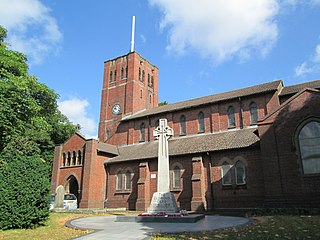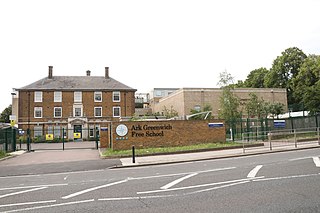Related Research Articles

The City of Westminster is a city and borough in London. It is the site of the United Kingdom's Houses of Parliament and much of the British government. It occupies a large area of central London, including most of the West End. Many London landmarks are within the borough, including Buckingham Palace, Westminster Abbey, Whitehall, Westminster Cathedral, 10 Downing Street, and Trafalgar Square.

West Bromwich is a market town in the borough of Sandwell, West Midlands, England. Historically part of Staffordshire, it is 7 miles northwest of Birmingham. West Bromwich is part of the area known as the Black Country, in terms of geography, culture and dialect. West Bromwich had a population of 103,112 in the 2021 Census.

Oldbury is a market town in the Metropolitan Borough of Sandwell, West Midlands, England. It is the administrative centre of the borough. At the 2011 census, the town had a population of 13,606, while the 2017 population of the wider built-up area was estimated at 25,488. Sandwell Metropolitan Borough Council, which defines Oldbury Town as consisting of the wards of Bristnall, Langley, Oldbury, and Old Warley, gave the population as 50,641 in 2011.

Rowley Regis is a town and former municipal borough in Sandwell in the county of the West Midlands, England. It forms part of the area immediately west of Birmingham known as the Black Country and encompasses the three Sandwell council wards of Blackheath, Cradley Heath and Old Hill, and Rowley. At the 2011 census, the combined population of these wards was 50,257.

King Edward VI Camp Hill School for Boys, also known as Camp Hill Boys, is a highly selective grammar school in Birmingham, United Kingdom. It is one of the most academically successful schools in the United Kingdom, currently ranked third among state schools. The name is retained from the previous location at Camp Hill in central Birmingham. The school moved to Vicarage Road in the suburb of Kings Heath in 1956, sharing a campus with its sister school, also formerly located in Camp Hill. It is a school which specialises in Science, Mathematics, and Applied Learning. In 2006, the school was assessed by The Sunday Times as state school of the year. A Year 9 student was 2011 winner of The Guardian Children's Fiction Page and the Gold Award in the British Physics Olympiad was won by a King Edward VI Camp Hill student in September 2011. Camp Hill has also sent a boy to the International Chemistry Olympiad for 4 years in a row. In the 2019 Chemistry Olympiad, Camp Hill received the second most gold certificates, coming second to St Paul's School, London.

Cradley Heath is a town in the Metropolitan Borough of Sandwell, West Midlands, England. It is 2 miles (3 km) north-west of Halesowen, 3 miles (5 km) south of Dudley and 8 miles (13 km) west of Birmingham.
Graveney School is a secondary school and sixth form with academy status in the Furzedown area of Tooting, southwest London, England. The school has a partially selective admissions policy. In the beginning of 2015, the school was assessed in an Ofsted inspection report as outstanding.

Montpelier High School is a girls secondary Academy, located in the Montpelier area of Bristol, England. The school building was designed by William Venn Gough and dates from 1891. It uses a polychrome mix of various Northern Renaissance styles, built in red Cattybrook brick with yellow brick and buff terracotta dressings, and has been designated by English Heritage as a grade II listed building.
The John Fisher School is a Roman Catholic voluntary-aided boys' faith school based at Peaks Hill, Purley, Croydon, Surrey, England. The school is located in and funded by the London Borough of Sutton. It occupies the former site of the 19th-century prep school Falconbury School. The school operates as a faith comprehensive School, educating boys mainly from south and central Croydon. It has a history of selection, and has drawn pupils from across London and South East England.
Q3 Academy Tipton is a coeducational secondary school located in Tipton in the West Midlands of England.

King Edward VI Camp Hill School for Girls, also known as Camp Hill Girls, is a selective grammar school in Kings Heath, Birmingham, for students aged 11 to 18. It is one of the most academically successful schools in the United Kingdom, currently ranked 10th among state schools. It is one of seven schools in Birmingham that are part of the King Edward VI Foundation. It shares a campus with King Edward VI Camp Hill School for Boys and, in 1958, both schools moved from their original location in central Birmingham to Vicarage Road in the Birmingham suburb of Kings Heath. The buildings are connected and some facilities and activities are shared, but they are separate establishments. The name has been retained from the school's former site at Camp Hill.
In human geography, a catchment area is the area from which a location, such as a city, service or institution, attracts a population that uses its services and economic opportunities. Catchment areas may be defined based on from where people are naturally drawn to a location or as established by governments or organizations for the provision of services.

Bexleyheath Academy is a mixed secondary school state school in Bexleyheath, in the London Borough of Bexley. Students typically join the school in year 7 or enter into the sixth form.
In England, a partially selective school is one of a few dozen state-funded secondary schools that select a proportion of their intake by ability or aptitude, permitted as a continuation of arrangements that existed prior to 1997. Though treated together by current legislation, they are of two types: bilateral schools in remnants of the Tripartite System, and former grant-maintained schools that introduced partial selection in the 1990s. While technically classified as comprehensive schools, they occupy a middle ground between grammar schools and true comprehensives, and many of the arguments for and against grammar schools also apply to these schools. Although there are relatively few schools of this type, several of them score very highly in national performance tables, and are among the most over-subscribed schools in the country.

Dunraven School is a 4–18 mixed, all-through school and sixth form with academy status in Streatham, Greater London, England. Its buildings are based over two sites that were previously used as a teacher training college and a primary school.
Bristol Free School (BFS) is a Secondary Academy which opened in Southmead, Bristol, England, in September 2011.

Ark Greenwich Free School is a co-educational secondary free school located in the Woolwich area of the Royal Borough of Greenwich in London, England. The school opened as Greenwich Free School in September 2012 with an initial intake of 11-year-old pupils, with the school expanding admissions every year to eventually become a full secondary school with a sixth form.
The Greenwich judgment of 1990 declared as unlawful a decision by Greenwich Local Education Authority (LEA) to give priority in school admissions to its own residents over residents from neighbouring LEAs, clarifying that applicants must be treated equally, whether they reside inside or outside the authority. It has been associated with a decline in the use of catchment areas as a means of managing school admissions, and an associated increase in cross-border mobility.
The 50% Rule in English faith school admissions was introduced in 2010 and stipulates that where newly established academies with a religious character are oversubscribed, at least 50% of their places must be open places, i.e. allocated without reference to faith. The rule is sometimes referred to as the Faith Cap on admissions. However, as the open places are just as accessible to faith applicants as non-faith applicants, in practice the rule does not explicitly prevent such schools from having more than 50% of students with a faith affiliation.
Trinity Academy is a mixed gender non-selective musical Secondary Academy, located in the Lockleaze area of Bristol, England. It is one of three secondary schools in the Cathedrals Schools Trust (CST) along with Bristol Cathedral Choir School and St Katherine's School. It is situated alongside Stoke Park Primary School.
References
- ↑ "Free school admissions guidance" (PDF). Department for Education. Retrieved 23 November 2018.
- ↑ "Admissions Policy for Europa School UK" (PDF). Oxfordshire.gov.uk. Retrieved 23 November 2018.
- ↑ "Sandwell Academy Centroid Points" (PDF). Sandwell Academy. Retrieved 23 November 2018.
- ↑ "Turnham Academy Admission Arrangements 2019/2020" (PDF). Turnham Academy. Retrieved 23 November 2018.
- ↑ "Admissions Policy". Fairlawn Primary School. Retrieved 23 November 2018.
- ↑ "Sandwell Academy Initiative Update". Sandwell Metropolitan Borough Council. Retrieved 24 August 2017.
- ↑ "Consultation Findings: School Admissions Criteria" (PDF). London Borough of Hillingdon. Retrieved 24 August 2017.
- ↑ "Admissions". Ealing Fields High School. Retrieved 23 November 2018.
- ↑ Scott, Shan. "Office of the Schools Adjudicator Annual Report, September 2015 to August 2016" (PDF). Office of the Schools Adjudicator. Department for Education. Retrieved 23 November 2018.
- ↑ "One Degree Academy Admissions Policy" (PDF). One Degree Academy. Retrieved 23 November 2018.
- ↑ Coughlan, Sean. "One school, four catchment areas". BBC. Retrieved 23 November 2018.
- ↑ "Admissions Policy and Procedure" (PDF). Health Futures UTC. Retrieved 23 November 2018.
- ↑ "School Admission Arrangements in Bristol" (PDF). Bristol Local Authority. Retrieved 23 November 2018.
- ↑ "The Piggott School". GOV.UK. Retrieved 2020-08-12.